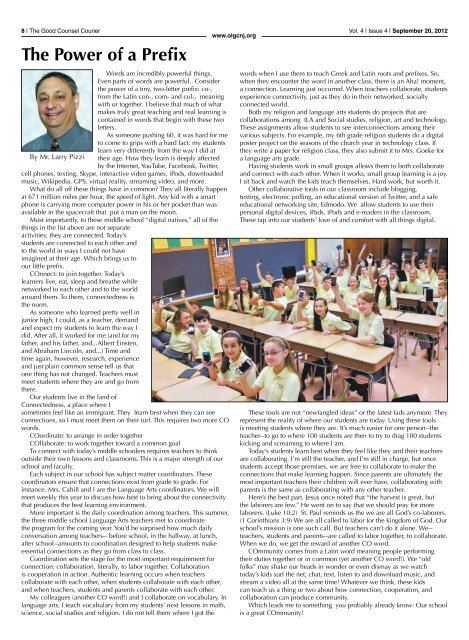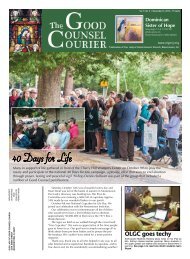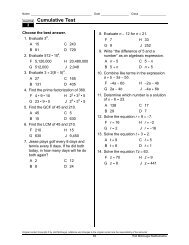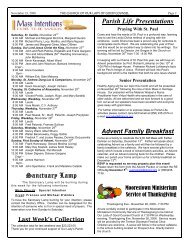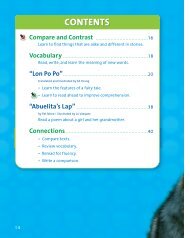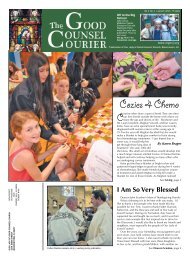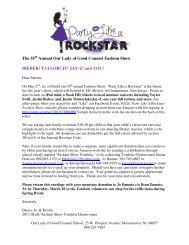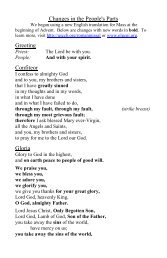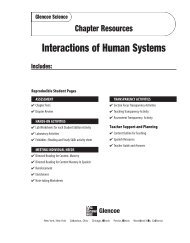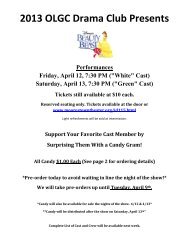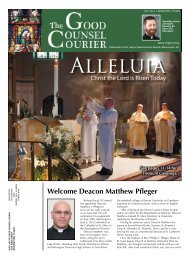OLGC New Teachers - Our Lady of Good Counsel
OLGC New Teachers - Our Lady of Good Counsel
OLGC New Teachers - Our Lady of Good Counsel
You also want an ePaper? Increase the reach of your titles
YUMPU automatically turns print PDFs into web optimized ePapers that Google loves.
8 | The <strong>Good</strong> <strong>Counsel</strong> Courier Vol. 4 | Issue 4 | September 20, 2012www.olgcnj.orgThe Power <strong>of</strong> a PrefixWords are incredibly powerful things.Even parts <strong>of</strong> words are powerful. Considerthe power <strong>of</strong> a tiny, two-letter prefix: co-,from the Latin con-, com- and col-, meaningwith or together. I believe that much <strong>of</strong> whatmakes truly great teaching and real learning iscontained in words that begin with these twoletters.As someone pushing 60, it was hard for meto come to grips with a hard fact: my studentslearn very differently from the way I did atBy Mr. Larry Pizzi their age. How they learn is deeply affectedby the Internet, YouTube, Facebook, Twitter,cell phones, texting, Skype, interactive video games, iPods, downloadedmusic, Wikipedia, GPS, virtual reality, streaming video, and more.What do all <strong>of</strong>f these things have in common? They all literally happenat 671 million miles per hour, the speed <strong>of</strong> light. Any kid with a smartphone is carrying more computer power in his or her pocket than wasavailable in the spacecraft that put a man on the moon.Most importantly, to these middle school “digital natives,” all <strong>of</strong> thethings in the list above are not separateactivities; they are connected. Today’sstudents are connected to each other andto the world in ways I could not haveimagined at their age. Which brings us toour little prefix.COnnect: to join together. Today’slearners live, eat, sleep and breathe whilenetworked to each other and to the worldaround them. To them, connectedness isthe norm.As someone who learned pretty well injunior high, I could, as a teacher, demandand expect my students to learn the way Idid. After all, it worked for me (and for myfather, and his father, and...Albert Einsten,and Abraham Lincoln, and...) Time andtime again, however, research, experienceand just plain common sense tell us thatone thing has not changed. <strong>Teachers</strong> mustmeet students where they are and go fromthere.<strong>Our</strong> students live in the land <strong>of</strong>Connectedness, a place where Isometimes feel like an immigrant. They learn best when they can seeconnections, so I must meet them on their turf. This requires two more COwords.COordinate: to arrange in order togetherCOllaborate: to work together toward a common goalTo connect with today’s middle schoolers requires teachers to thinkoutside their own lessons and classrooms. This is a major strength <strong>of</strong> ourschool and faculty.Each subject in our school has subject matter coordinators. Thesecoordinators ensure that connections exist from grade to grade. Forinstance, Mrs. Cahill and I are the Language Arts coordinators. We willmeet weekly this year to discuss how best to bring about the connectivitythat produces the best learning environment.More important is the daily coordination among teachers. This summer,the three middle school Language Arts teachers met to coordinatethe program for the coming year. You’d be surprised how much dailyconversation among teachers-- before school, in the hallway, at lunch,after school--amounts to coordination designed to help students makeessential connections as they go from class to class.Coordination sets the stage for the most important requirement forconnection: collaboration, literally, to labor together. Collaborationis cooperation in action. Authentic learning occurs when teacherscollaborate with each other, when students collaborate with each other,and when teachers, students and parents collaborate with each other.My colleagues (another CO word!) and I collaborate on vocabulary. Inlanguage arts, I teach vocabulary from my students’ next lessons in math,science, social studies and religion. I do not tell them where I got thewords when I use them to teach Greek and Latin roots and prefixes. So,when they encounter the word in another class, there is an Aha! moment,a connection. Learning just occurred. When teachers collaborate, studentsexperience connectivity, just as they do in their networked, sociallyconnected world.Both my religion and language arts students do projects that arecollaborations among ILA and Social studies, religion, art and technology.These assignments allow students to see interconnections among theirvarious subjects. For example, my 6th grade religion students do a digitalposter project on the seasons <strong>of</strong> the church year in technology class. Ifthey write a paper for religion class, they also submit it to Mrs. Goeke fora language arts grade.Having students work in small groups allows them to both collaborateand connect with each other. When it works, small group learning is a joy.I sit back and watch the kids teach themselves. Hard work, but worth it.Other collaborative tools in our classroom include blogging,texting, electronic polling, an educational version <strong>of</strong> Twitter, and a safeeducational networking site, Edmodo. We allow students to use theirpersonal digital devices, iPads, iPods and e-readers in the classroom.These tap into our students’ love <strong>of</strong> and comfort with all things digital.These tools are not “newfangled ideas” or the latest fads anymore. Theyrepresent the reality <strong>of</strong> where our students are today. Using these toolsis meeting students where they are. It’s much easier for one person--theteacher--to go to where 100 students are then to try to drag 100 studentskicking and screaming to where I am.Today’s students learn best when they feel like they and their teachersare collaborating. I’m still the teacher, and I’m still in charge, but oncestudents accept those premises, we are free to collaborate to make theconnections that make learning happen. Since parents are ultimately themost important teachers their children will ever have, collaborating withparents is the same as collaborating with any other teacher.Here’s the best part. Jesus once noted that “the harvest is great, butthe laborers are few.” He went on to say that we should pray for morelaborers. (Luke 10:2) St. Paul reminds us the we are all God’s co-laborers.(1 Corinthians 3:9) We are all called to labor for the kingdom <strong>of</strong> God. <strong>Our</strong>school’s mission is one such call. But teachers can’t do it alone. We--teachers, students and parents--are called to labor together, to collaborate.When we do, we get the reward <strong>of</strong> another CO word.COmmunity comes from a Latin word meaning people performingtheir duties together or in common (yet another CO word!). We “oldfolks” may shake our heads in wonder or even dismay as we watchtoday’s kids surf the net, chat, text, listen to and download music, andstream a video all at the same time! Whatever we think, these kidscan teach us a thing or two about how connection, cooperation, andcollaboration can produce community.Which leads me to something you probably already know: <strong>Our</strong> schoolis a great COmmunity!


